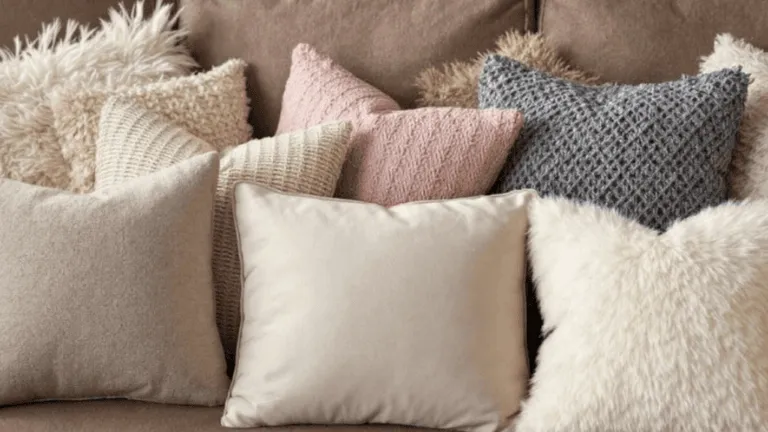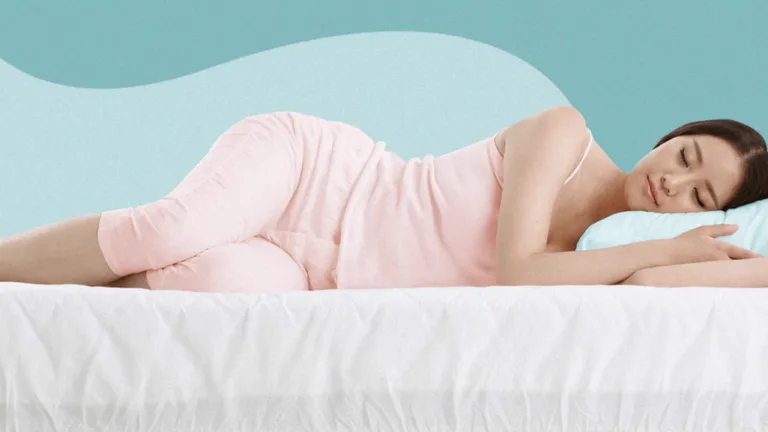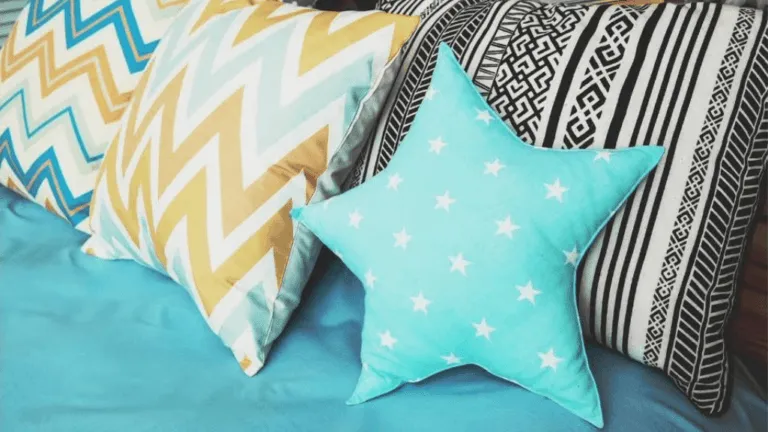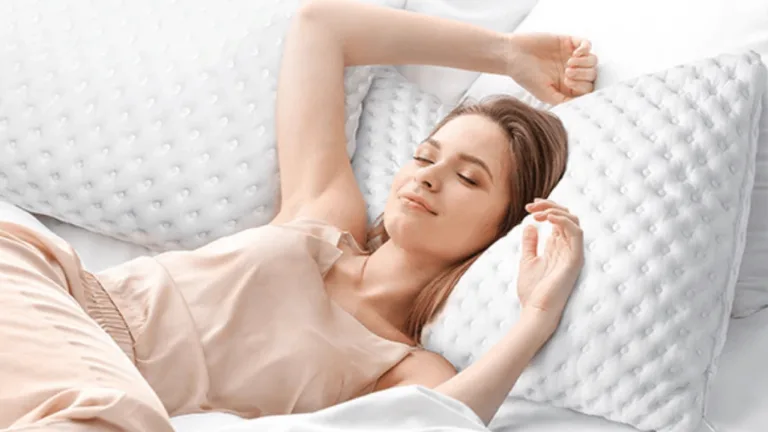Finding the right throw pillow covers can be tough, especially with all the sizes out there. Knowing the throw pillow cover sizes and how they fit with pillow inserts is key. This guide will help you understand the standard sizes to make better choices.
When buying throw pillow covers, think about the pillow insert size. The right insert makes your pillows look great. Colin and Finn, a trusted pillow seller, offer tips on sizing and insert fill materials. They say to pick an insert 2″ bigger than the cover for a full look.
For example, a 20×20 cover needs a 22×22 insert. But, for lumbar pillows, use an insert the same size as the cover to avoid too much stuffing.
Key Takeaways
- Understanding throw pillow cover sizes is essential for achieving the desired look in your home decor.
- The proper pillow insert size is crucial for creating full and plump throw pillows.
- For square pillow covers, choose an insert 2″ larger than the cover size.
- Lumbar pillow covers should have an insert the same size as the cover to prevent overstuffing.
- Consider the fill material of the insert, such as feather or down alternative, for the desired feel and appearance.
Understanding Standard Throw Pillow Cover Sizes
Decorating your home with throw pillows is easier when you know the standard sizes. Throw pillows come in shapes and sizes that add to your space’s look and feel. We’ll look at common sizes, including square and rectangular lumbar options, to help you pick the right throw pillows.
The most common sizes are 18×18 inches, 20×20 inches, and 22×22 inches. These sizes fit well with many furniture styles and room layouts. Choose an insert that’s 2 inches larger than the cover size for a full look. For example, a 20×20 inch cover goes well with a 22×22 inch insert.
Square Pillow Cover Sizes
Square throw pillows are popular for their symmetry and versatility. They come in sizes like 16×16 inches, 18×18 inches, 20×20 inches, and 23×23 inches. These sizes fit different preferences and room sizes. Choose square pillows that match your furniture and room size for a balanced look.
For comfort and support, consider the fill material of your pillow inserts. Feather inserts offer a good balance of firmness and flexibility. Down alternative inserts are also a good choice, especially for those with allergies.
Rectangular Lumbar Pillow Cover Sizes
Rectangular lumbar pillows add a unique touch and support to your decor. Standard sizes are 10×20 inches and 15×22 inches. These sizes are great for sofas, loveseats, or beds. They also add a decorative accent with contrasting colors or textures.
When picking lumbar pillow covers, think about your furniture size and support needs. A pillow insert size guide can help find the right size for your lumbar pillow covers.
| Pillow Cover Size | Recommended Insert Size |
|---|---|
| 16×16 inches | 18×18 inches |
| 18×18 inches | 20×20 inches |
| 20×20 inches | 22×22 inches |
| 22×22 inches | 24×24 inches |
| 10×20 inches (lumbar) | 12×22 inches |
| 15×22 inches (lumbar) | 17×24 inches |
Knowing the standard sizes for throw pillows helps create a stylish and cohesive look in your home. Whether you like square or lumbar pillows, choosing the right sizes and inserts will make your space more comfortable and visually appealing.
Choosing the Right Pillow Cover Size for Your Furniture
When picking the right pillow cover sizes, think about your furniture’s size and style. The right size can make your sofa, loveseat, or armchair look better and feel more comfortable. Choosing the right sizes can make your living space look and feel great.
Pillow Cover Sizes for Sofas and Couches
For big or deep sofas and couches, 24-inch and 22-inch pillow covers work well. They offer good support and make the space cozy. If your sofa is shallower, 20-inch covers might be better.
When placing throw pillows on a sofa, use an odd number like three or five. This depends on the couch’s size and depth.
Lumbar pillows add a nice touch to sofas and couches. Good sizes for couch lumbar pillows are:
- 16 inches x 20 inches
- 14 inches x 22 inches
- 12 inches x 20 inches
To make pillows look full, get inserts one size bigger than the covers. Unless the seller says otherwise.
Pillow Cover Sizes for Loveseats
For loveseats, use two 20-inch pillow covers in the front and two 24-inch covers in the back. This makes the loveseat look balanced and inviting. It’s perfect for reading or chatting.
A well-styled loveseat with the right pillow cover sizes can transform a simple seating area into a warm and welcoming space.
Pillow Cover Sizes for Armchairs
Armchairs need smaller pillow covers than sofas and loveseats. An 18×18 inch cover is ideal for most armchairs. It adds comfort and support without taking over the chair.
| Furniture Type | Recommended Pillow Cover Sizes |
|---|---|
| Sofa (Large/Deep) | 24 inches, 22 inches |
| Sofa (Shallow) | 20 inches |
| Loveseat | 20 inches (front), 24 inches (back) |
| Armchair | 18 inches x 18 inches |
Choosing the right pillow cover sizes for your furniture makes your space look and feel better. It adds style and comfort to your living area.
Throw Pillow Cover Sizes for Beds
Choosing the right pillow cover sizes is key for a stylish bed. The most common sizes are 18″x18″ and 20″x20″. But, bigger beds might need larger sizes for a balanced look.
For a king-sized bed, use three to four 24×24 inch pillows. Add two 20×20 inch pillows and a lumbar or circular throw pillow in front. This creates a layered, inviting look that highlights the bed.
On a queen-sized bed, start with three 24×24 inch pillows. Layer with two 20×20 or 18×18 inch pillows and a lumbar pillow in front. This mix offers a balanced, appealing display of pillow sizes.
Twin beds look great with one or two 20×20 inch square pillows and a lumbar or circular throw pillow in front. This setup is perfect for smaller beds, adding a touch of style without overwhelming the space.
The key to a polished look is mixing sizes and shapes while keeping a cohesive color scheme.
Remember, the insert should be slightly larger than the cover for a plump look. Choose an insert 2 inches larger than the cover size. For example, a 20×20 inch cover needs a 22×22 inch insert.
| Bed Size | Recommended Pillow Cover Sizes |
|---|---|
| King | 3-4 24×24″, 2 20×20″, 1 lumbar or circular |
| Queen | 3 24×24″, 2 20×20″ or 18×18″, 1 lumbar |
| Twin | 1-2 20×20″, 1 lumbar or circular |
By following these guidelines, you can make a stunning, inviting bedroom. It will show off your style and offer a cozy, relaxing space.
Mixing and Matching Pillow Cover Sizes
Mixing pillow cover sizes can make your living space look great and feel cozy. By using different sizes, shapes, and textures, you can add depth and interest. The trick is to balance them well and pick the right sizes for your space.
Creating a Balanced Look
Getting a balanced look with mixed pillow sizes is key for a welcoming space. Use an odd number of pillows, like three or five, for a modern feel. Even numbers, such as two or four, work better for a traditional look. Here are some tips for arranging your pillows:
- Use a range of three different pillow sizes to create visual interest and depth
- Combine square and lumbar pillow covers for a well-rounded arrangement
- Layer larger pillows in the back and smaller ones in the front for a cohesive look
- Experiment with different textures, such as velvet, linen, or knit, to add tactile appeal
For example, on an 80″ wide sofa, start with three 20×20 inch square pillows in the back. Then, add one or two 12×24 inch lumbar pillows in front. This mix creates a balanced and inviting look that encourages relaxation. Studio McGee suggests in their article on effortlessly mixing and matching pillows that playing with scale and shape is crucial.
Combining Different Pillow Cover Shapes
Adding different shapes to your pillow mix can make your space even more interesting. You can find square, rectangular (lumbar), circular, bolster, or novelty shapes. Here are some tips for mixing shapes:
- Use square pillows as a foundation and layer in rectangular or novelty shapes for contrast
- Pair a large square pillow with a smaller lumbar pillow for a balanced look
- Mix and match patterns and solids in different shapes to create a dynamic arrangement
- Consider the scale of your furniture when choosing pillow cover shapes and sizes
For a smaller sofa or loveseat, try two 18×18 inch square pillows and one 12×20 inch lumbar pillow. This avoids overwhelming the space. On a larger sectional, use three 22×22 inch square pillows in the center, flanked by two 20×20 inch pillows on each end for a luxurious look.
| Furniture Type | Suggested Pillow Cover Sizes and Shapes |
|---|---|
| Standard Sofa (80″ wide) | 3 x 20×20″ square + 1-2 x 12×24″ lumbar |
| Loveseat (50-60″ wide) | 2 x 18×18″ square + 1 x 12×20″ lumbar |
| Sectional (variable sizes) | 3 x 22×22″ square (center) + 2 x 20×20″ square (ends) |
| Armchair | 1 x 20×20″ square or 1 x 18×18″ square + 1 x 12×20″ lumbar |
Remember, these are just guidelines, and the beauty of mixing and matching pillow cover sizes lies in the opportunity to create a unique and personalized look that reflects your style and complements your space.
By mixing different sizes, shapes, and textures of throw pillow covers, you can make your living space more inviting. This creates a cozy atmosphere perfect for relaxation and comfort.
Pillow Insert Sizing Guide
Choosing the right pillow insert size is key for perfect throw pillows. The ideal size depends on your pillow cover and how full you want it. We’ll show you how to pick the best pillow filler for different sizes and how to make them look plump and luxurious.
Determining the Right Insert Size for Your Pillow Cover
For the best look, pick a pillow insert that’s a bit bigger than your cover. This makes your pillows look fuller and more inviting. Here are some tips for choosing the right insert size based on common cover sizes:
| Pillow Cover Size | Recommended Insert Size |
|---|---|
| Small Square (17″x17″ and smaller) | Size up 1″ (e.g., 18″x18″ insert for a 17″x17″ cover) |
| Medium Square (18″x18″-20″x20″) | Size up 2″ (e.g., 20″x20″ insert for an 18″x18″ cover, 22″x22″ insert for a 20″x20″ cover) |
| Large Square (22″x22″- 24″x24″) | Size up 2-3″ (e.g., 24″x24″ insert for a 22″x22″ cover) |
| Extra Large Square (26″x26″ and larger) | Size up 3-4″ |
| Small Lumbar (11″x19″-11″x23″) | Size up 1″ (e.g., 12″x20″ insert for an 11″x19″ cover, 12″x24″ insert for an 11″x23″ cover) |
| Medium Lumbar (14″x22″- 15″x23″) | Size up 1-2″ (e.g., 16″x24″ down/feather insert works well) |
| Large Lumbar (13″x34″- 18″x48″) | Size up 2-3″, mainly on the longer side |
For lumbar pillows, choose an insert that matches the cover size. This avoids making the pillow too bulky and uncomfortable.
Achieving a Plump and Full Appearance
The right pillow insert size is just the start. The fill material also affects how your pillows look and feel. Here are some tips for a plump and luxurious look:
- Feather inserts with a “90% gray duck feathers/10% goose down” ratio are ideal for decorative throw pillows, offering a balance of support and flexibility.
- Down alternative inserts with a “50% woven cotton/50% poly” ratio provide a combination that brings support and flexibility without the use of feathers.
- Feather down pillow inserts are best suited for achieving the “karate-chop” look in pillows, although some premium alternative down options can also provide a similar appearance.
To achieve a full and plump look, it is recommended to select a pillow insert that is 2″ larger than the corresponding pillow cover size.
By following these guidelines and choosing the right fill material, you can make your throw pillows look and feel luxurious. This will enhance the look of your space.
Throw Pillow Cover Materials and Their Impact on Size
Choosing the right throw pillow cover is key. The material you pick affects the pillow’s size and look. Each fabric has its own traits that change how the pillow fits and looks.
Cotton, linen, and silk are favorites for their softness and elegance. They make pillows look relaxed and may need bigger inserts for a full look. Polyester and microfiber, on the other hand, are durable and keep their shape well.
The material of your throw pillow cover can greatly impact the size and overall appearance of your throw pillows, so it’s essential to consider the fabric’s properties when selecting the perfect fit.
Think about the fabric’s stretch when choosing an insert. Knit or stretchy fabrics need bigger inserts. Sturdy fabrics can do with smaller inserts. A good rule is to use an insert 2 inches bigger than the cover for a nice plump look.
| Pillow Cover Material | Characteristics | Insert Size Recommendation |
|---|---|---|
| Cotton | Soft, breathable, and natural | 2 inches larger than cover size |
| Linen | Durable, textured, and relaxed | 2 inches larger than cover size |
| Silk | Smooth, lustrous, and luxurious | 1-2 inches larger than cover size |
| Polyester | Durable, easy to clean, and wrinkle-resistant | 1-2 inches larger than cover size |
| Velvet | Plush, soft, and elegant | 2 inches larger than cover size |
Choosing throw pillow cover materials depends on your taste and needs. Knowing how fabrics affect size and look helps create a cozy space.
Decorating with Different Pillow Cover Sizes
When decorating with pillow cover sizes, aim for a balanced look. Mix sizes, shapes, and patterns to make your space cozy or modern. This approach can transform your area into a welcoming spot or a sleek retreat.
Using Oversized Pillow Covers for a Cozy Feel
Oversized pillow covers add warmth and comfort to your space. They make your room feel plush and inviting. Choose soft materials like chunky knits, velvet, or faux fur for extra coziness.
Stick to a color scheme that matches your room’s decor. Neutral colors like beige, gray, and cream work well with most themes. Mix textures and patterns in your chosen colors to add depth and interest.
Incorporating Smaller Pillow Covers for a Modern Look
Smaller pillow covers give your space a clean, modern look. They help keep your room tidy and streamlined. Use pillows with clean lines, geometric patterns, and bold colors for a modern vibe.
For a balanced look, mix square and rectangular lumbar pillows in different sizes. Lumbar pillows support your back and add length to your space. Use various materials like linen, cotton, and leather to add texture and interest.
The key to a successful pillow arrangement is to mix and match different sizes, shapes, and patterns while maintaining a cohesive color scheme.
When styling your pillows, consider these design elements:
- Color
- Shape
- Size
- Texture
- Pattern
- Arrangement
- Comfort
Try out different pillow covers, like faux leather and geometric designs. Stores like World Market and West Elm have great options. Use neutral designs for easy mixing and layer different patterns and textures for a unique look.
| Pillow Pattern | Characteristics | Placement |
|---|---|---|
| Geometric | Clean lines, bold shapes | Middle layer |
| Organic | Soft, curved lines, natural motifs | Front layer |
| Textured/Solid | Adds depth and interest | Back layer |
By combining different pillow cover sizes, materials, and patterns, you can create a space that reflects your style. Decorating with throw pillows is fun and affordable. It’s a great way to refresh your home’s look.
Pillow Cover Size Trends
Throw pillow covers are key in interior design, helping to tie a room together. Keeping up with the latest trends can make your space stylish and welcoming. By choosing the right sizes and materials, you can show off your unique style.
Popular Pillow Cover Sizes for Current Interior Design Styles
Experts say square and lumbar pillows are in style. Square covers, from 18″ x 18″ to 24″ x 24″, are versatile. They work well together for a balanced look. Lumbar covers, like 12″ x 20″ or 16″ x 24″, add elegance and complement squares.
For a sofa, mix 22-24″ and 20-22″ squares for a traditional or casual vibe. Sectionals look cozy with a mix of sizes and shapes. This creates a welcoming feel.
| Furniture Type | Recommended Pillow Cover Sizes | Number of Pillows |
|---|---|---|
| Sofa | 22-24″ and 20-22″ square pillows | 4-5 pillows |
| Sectional | 22-24″ square, 20-22″ square, and lumbar pillows | 7-10 pillows |
| Twin Bed | 22″ square and lumbar pillows | 1-2 decorative pillows |
| King/Queen Bed | 24-26″ square, lumbar, and long lumbar or headboard pillows | 3-5 decorative pillows |
Current trends also focus on different design styles. For a modern look, use 16″ x 16″ to 18″ x 18″ covers. Oversized covers, like 24″ x 24″ or bigger, bring a cozy feel to spaces like bohemian or rustic.
By staying informed about popular pillow cover sizes and current interior design pillow trends, you can elevate your space and create a cohesive, stylish look that reflects your personal taste.
Tips for Measuring and Purchasing Throw Pillow Covers
Getting the right size for throw pillow covers is key. Start by measuring your pillow inserts carefully. Remember to include the fill material and how plump you want them to be. For a full look, pick a cover 2″ smaller than your insert size.
For lumbar pillows, choose a cover that matches the insert size. This prevents them from getting too stuffed. Think about the fill material too. For example, feather inserts with a mix of gray duck feathers and goose down are soft yet firm. Down alternative inserts, made of cotton and poly blend, are good for those with allergies.
When buying pillow covers, go for trusted retailers with lots of sizes, materials, and styles. Read product descriptions and reviews to find quality and value. Remember, pillow sizes are often rounded up to the nearest inch. So, compare the exact measurements from the retailer.
If you’re not sure about a pillow cover’s size, call the retailer. For example, Pillow Decor is at 1-866-900-8488 for exact measurements. By following these tips, you can find the perfect throw pillow covers. This will make your living space more comfortable and stylish.
When picking throw pillow covers, think about your furniture size. Common sizes for sofas are 18″x18″ and 20″x20″. Larger sofas might need 22″x22″ or 24″x24″ pillows. There are specific sizes for loveseats, armchairs, and beds too.
Small insert sizes are great for decorating small benches or reading nooks. But, they might not support adults’ backs. Choose the right sizes for your furniture and style to make your home inviting. For more tips on choosing the best pillow for neck pain, check out expert advice.















